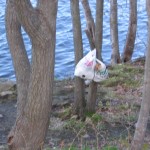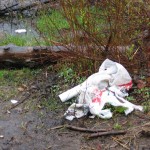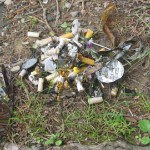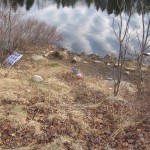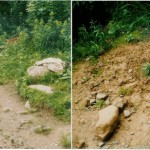Public Use Lake Closures\Harmful Stormwater Run-off
The first known occurrences of extremely high levels of fecal coliform and E. Coli in the lake took place in 2008 and again in 2009. While some contributors are known (see pet waste below), the high levels seen in these years suggests there are other sources which need to be identified and remedial action taken.
The lake is subject to the negative impacts of fertilizer and pesticide usage, the use of storm sewers to dump harmful products, and the dumping of grass clippings and other yard waste down the bank (Lorne Ave. side) and into parkland (Cranston Ave. and Oathill Crescent side). Poor drainage along the pathways adjacent to the lake leads to additional erosion and nutrient enrichment. Run-off of excess nutrients can lead to algal blooms and increased aquatic plant cover that can negatively affect the habitat for fish and other organisms. Excessive growth of plants in the lake also reduces access for swimming and fishing.
One contributor to elevated fecal and E. Coli levels in the lake is pet waste. A recent investigation by HRM found E. Coli levels in the lake to be above those considered safe by the Canadian Council of Ministers of the Environment Human Health Criteria; the high coliform levels were in part attributed to dog waste bags having been disposed of in stormwater catch basins. Please be responsible and follow the city bylaws and pick up after your pets and dispose of the waste properly. Dog droppings around the shoreline of lake also add to the coliform levels in the lake during rain events and put human health and the lake’s ecology (nutrient loading) at increased risk.
The winter salting of some streets which drain into the lake leads to increased salt loading. The potential increased salinity of the lake affects its water quality and habitat suitability.
Stormwater Catchment Area – Click for image (red line on drawing indicates stormwater catchment area)
Invasive Species
Invasive species are non-indigenous, aggressive plants that are a threat to the native species surrounding them. Three invasive species have been identified around Oathill Lake. These include the Multiflora Rose, Japanese Knotweed, and Himalayan Balsam (see Invasive Species Info sheet for pictures). Work is continuing to be done to eradicate these species, however due to their aggressive nature, constant monitoring of the area is required to ensure their growth and spread is minimized. The locations of these invasive species has been tagged using a GPS system to help in this yearly monitoring process (see map below).
Invasive Species Info – Click for image
Invasive Species Map – Click for image
Litter
Littering of the shoreline with general garbage (food wrappers, coffee cups, butts, etc.) is unsightly and, in the case of monofilament line and hooks, dangerous to both wildlife and the public. Click to enlarge images of the following thumbnails pictures of shoreline damage and trash (monofilament line, hooks, lure packaging, bait containers and cigarette butts).
Shoreline Degradation
There has been severe degradation of shoreline habitat (ground and vegetative cover) due to fishing activities. Excessive fishing-related foot traffic about and along the shoreline, particularly in wet weather, destroys vegetative ground cover. This type of damage has been further intensified with the newly-introduced year-round fishery season. This change of season adds at least a full month of activity on the shoreline during the wettest period of the year. Bait digging (digging for worms and turning up rocks for bait) also contributes to shoreline damage.
OathillLake_portrait (Click to View Shoreline Damage)
Loss of Amphibian Populations
There has been a loss of amphibian populations (particularly frogs) around Oathill Lake. Although other factors may be contributing, this decline is likely due to heavy predation by the excessive numbers of trout being stocked in the lake. When stocked, non-native fish prey on and compete with native species for food and habitat. Additionally, stocked fish can alter the natural ecosystem to the detriment of native species. Click the following links to view scientific and information reports.

